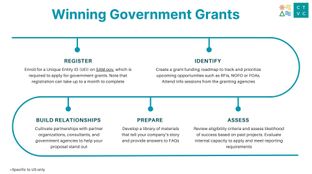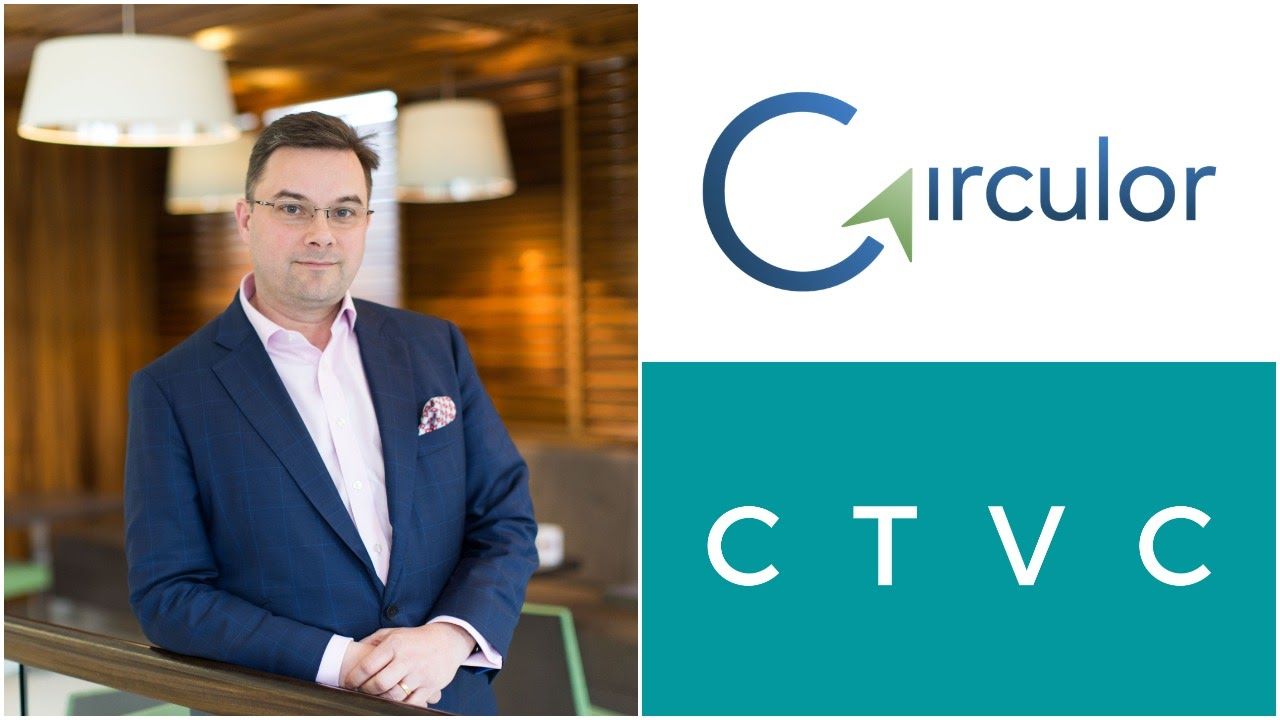
🌎 Get ready with me: Government grants edition 💅💵
A founder’s guide to winning non-dilutive funding with Elemental Excelerator
How supply chain traceability leads us to Net Zero

Everything seems to be in short supply these days, especially batteries. This week, Biden announced an Executive Order to “shore up” battery supply chains, as batteries play a critical role in the energy transition. In the same week, we sat down with Doug Johnson-Poensgen, CEO of Circulor, about his vision of providing complete supply chain traceability to enable responsible sourcing and emissions tracking. Circular just closed a fresh $14m Series A from The Westly Group, Salesforce Ventures, BHP Ventures, Future Positive Capital and others.
Let’s “trace” back to the beginning. What’s the origin story of Circulor?
My career has always revolved around technology. In the early 2010s I was running the defense and security business of BT (British Telecom) when my cryptographers first brought up this little thing called Bitcoin. I became intrigued by blockchain and its potential for real world applications beyond cryptocurrencies. The use of new technologies to unlock old problems always excited me, and my now co-founder Veera Johnson and I started spitballing ideas about enterprise-scale problems that these new technologies (e.g., IoT, blockchain, machine learning) could help unlock.
Veera and I seized on the complexity of supply chains for materials such as cobalt, which is used in lithium ion batteries and has all sorts of responsible sourcing concerns. 60% of the world's cobalt is mined in Congo where it’s associated with the funding of armed groups and use of child labor. If you're Apple or an EV manufacturer, that's clearly not something you want in your supply chain. So we started off thinking of ways to use blockchain to create a reliable provenance for materials that change between source and product.
How is supply chain traceability relevant to climate tech?
The World Economic Forum published a really good report showing that just eight highly polluting supply chains account for ~50% of total global emissions. Reducing the emissions of these supply chains is the defining problem of our age. Last year, when we all went into lockdown, global carbon emissions fell by 7% - which the Paris Agreement requires every year. During lockdown the global economy all but ground to a halt and we still only reduced carbon emissions by seven percent. The reason is supply chains.
Automotive and electronics are two of those eight dirtiest supply chains, driven primarily by batteries. Eventually new battery technologies, sustainable raw materials, and better recycling systems will clean up battery supply chains. But in reality, the production and recycling of batteries require a massive amount of (mostly nonrenewable) energy. Batteries power the energy transition but have two major problems: (1) responsible sourcing and (2) the massive amount of energy necessary to create them. Carbon emissions from battery supply chains are the dark secret behind electric vehicles. Likewise, steel and aluminium are very emissions intensive. Car manufacturers declaring 2030/2040 net zero emissions targets face massive challenges reducing their supply chain carbon emissions.
What role does Circulor play in tracking and reducing emissions embedded in supply chains?
We provide complete transparency into the carbon flow of materials through the supply chain from raw material to the manufacturers themselves. We attribute the emissions created by each participant to specific steps in the material flow. It’s a far more accurate way of understanding supply chain Scope 3 emissions and provides a basis for companies to buy smarter without investing huge amounts in custom R&D to identify all the other ways to reduce embedded carbon.
A life cycle assessment spits out a total embedded carbon number, but doesn't help with an approach to actually reduce Scope 3 carbon footprints. We’re attracting attention because we’re combining insights with action. A host of car manufacturers use our technology to demonstrate responsible sourcing of critical raw materials including nickel (which is associated with deep sea tailings in the Pacific Ocean) and lithium (which raises concerns about water sources in dry places like the Chilean Atacama Desert). These sustainable supply chains ensure that batteries - essential for the energy transition - make for a better planet, rather than make things worse.
Which industries most acutely feel the need for supply chain traceability? What have been the key problems they face when trying to visualize their supply chain?
We focus on complex industrial supply chains, where materials change between source and consumption - whether it's freshly mined cobalt becoming a battery or a battery that’s taken apart and recycled into its next form factor. It's complicated because mined material doesn't have a unique form. It's not like tracking a diamond, which is a diamond from when you dig it up to when it’s cut, polished, and put into a piece of jewelry. For many mined materials, you're starting with a pile of earth that undergoes various forms of smelting and refining before going from component to sub-assembly to car. That's inherently a more complicated tracking challenge because at every one of those transformation steps, you have to reliably connect the input ingredients to the output product. You then have to combine that data with self reported data from supply chain participants and third party information to build trust in that chain of custody. These transformations happen multiple times on the journey from mine to car.
Another example is hard to recycle plastics. Today, the majority of plastic recycling is mechanical recycling. The challenge is that the economics of the global plastics supply chain are optimized for the first and single use of plastic. The only place at the moment where the economics of traceability and recycling makes sense is hard to recycle plastics, particularly for engineering purposes. We’re working with car manufacturers and oil majors like Total to be able to track plastic from waste through the whole process of recycling and back into something else. Europe’s Green Deal is introducing plastic taxes, which will require manufacturers to demonstrate what proportion of their product comes from recycled sources. So traceability within recycling has to become ubiquitous.
We are also working with other materials. For instance, we’re doing a project with a car manufacturer around leather traceability - literally from “cow to car”. Leather is a byproduct of cattle, which is a significant source of deforestation in places like South America. We're also working on tracing mica from industrial mines in Russia. Mica is not only used in cosmetics, but also for things like heat shields inside EVs. These are all examples of complex industrial supply chains where materials change on their journey from source to consumption.
How do companies currently monitor their supply chains? Why does Circulor’s platform offer a better solution?
Our biggest competitor is the spreadsheet. Today, companies will send out questionnaires to their suppliers asking, “Where have you sourced your conflict minerals from,” or “Provide me with some assurance that your cobalt is responsibly sourced.” The reality is that the status quo of seeking assurances from your supply chain is no longer good enough. Financial investors and institutional capital are increasingly expecting proof of ESG performance. That means that despite an inconsistency of standards, we're moving rapidly beyond the glossy brochure stage to meaningfully demonstrating responsible sourcing practices and Scope 3 product emissions reduction.
Who are your customers and how do they use Circulor to develop more sustainable supply chains?
Our customers include downstream OEMs such as car manufacturers or consumer electronics companies. Some of our customers in the auto industry include Volvo, Polestar, Daimler, and Jaguar Land Rover. We’re also about to kick off a big project with Boeing. In the industrial space, we’re working with companies like CNH Industrial which makes everything from trucks to tractors. Upstream, we’re working with mining companies like BHP who want to demonstrate the responsibility and sustainability of their operations. It’s essential to make sure that any sustainability benefits from upstream raw materials aren’t being lost in the midstream. We’ve been working with BHP, who mines sustainable nickel, and a very well known EV manufacturer as the bookend to the supply chain to ensure that midstream players maintain - or enhance - sustainability benefits. The key challenge to ESG metrics for materials in complex supply chains is attaching meaningful performance credentials to parcels while ensuring that midstream participants do not destroy any of the raw material’s sustainability benefits.
You can't manage something that you can't measure. For the first time, we’re helping car manufacturers to actually understand what's going on at every step of their supply chains so they can use their buying behavior as a driver for sustainability change. Polestar, a spinout of Volvo, just published a target to create the first carbon zero car by 2030. That’s massively challenging! Polestar named us as one of their key partners to digitize their supply chain and map the carbon emissions of participants within it.
What’s the technology backend? What data inputs are you pulling from, and how is Circulor able to achieve complete supply chain visibility?
It’s a symphony of technologies used in different ways along the supply chain. When you're first trying to create a digital twin for a commodity, for example at a mine site in the Congo, you need to find a way to give an identity to a blob of stuff and know who the actors are, where it came from, and what the working conditions were like. No one technology can do all of that. We combine physical due diligence with a digital tracer.
With each manufacturing step, the supply chain becomes increasingly more digitized, for example via production management systems used by refineries. Further downstream, data access increases alongside quality management purposes. Refiners’ quality management systems connect input ingredients to their plants’ outputs. We take a subset of that data via API into our platform and stitch it together to create a digital thread for the flow of materials. Each participant and facility in the supply chain has data around energy consumption, and some even have Scope 1 and 2 emissions. Therefore, if we know what proportion of output over a given timeframe goes from a particular plant to the next step in the supply chain, we can attribute a proportion of emissions to that material flow and calculate it across entire supply chain networks. It’s inherently complicated because relationships between supply chain participants aren’t 1:1 or even 5:4. Material comes from all sorts of places, governed by market forces like availability and price.
The net zero-motivated downstream buyer
has almost no visibility and no control over buying behavior in the midstream. Increasingly, car manufacturers and large consumer electronics companies are starting to work with their Tier 1 suppliers to improve sustainability. That means working with supply chain participants to source based on a combination of price, quality and sustainability metrics - not just price and quality.
How does blockchain technology play a role? Why is supply chain a good application for its features?
There is no global authority or United Nations agency of responsible sourcing. So who would host a database? Supply chain management thus lends itself well to the concept of a distributed ledger. The fundamental challenge in supply chains is a lack of trust. Supply chain fraud is as old as mankind. Just because I have a paper trail doesn’t mean that's the truth, even in sophisticated supply chains. Blockchain enables you to create a digital identity for a commodity and follow it through a supply chain, validating each step. Additionally, you can look for anomalies using tools like machine learning.
Blockchain also enables notarization, which means that history can't be rewritten if it's inconvenient. The timescale between someone digging up cobalt in the Congo to becoming a car is a minimum of six months. The people who are doing the digging, smelters, and refiners have no idea where their output will go. Ideally you're capturing data in real time that is selectively unlocked as material flows through the supply chain and ultimately to a car manufacturer. This allows you to discover things, such as a material being introduced from an unknown source, and leads to better supply chain mapping. As a result, Volvo Cars’ first fully electric vehicle, the XC40 Recharge, comes with complete traceability from mines to manufacturer for battery materials.
Supply chain participants become paying members of our platform because regardless of where they sit in the supply chain, they benefit from being able to share credentials or tokenized data with their customers. They’re able to differentiate their material from others because it comes with tracked sustainability metrics.
Corporate net zero commitments are driving companies to think about how to decarbonize upstream in their supply chain. How does Circulor fit into the picture?
Companies making net zero commitments have to be able to measure their Scope 3 emissions. To do that, they are going to have to fully understand their supply chains. For a car manufacturer like Volvo or Polestar, ~30% of the total embedded emissions in their new EVs come from their own facilities. Many car manufacturers already have some plants that are carbon neutral. But, the real challenge is the other 70% contribution from the supply chain, half of which is attributable to the battery. So if these companies are setting net zero targets, they've got to get a grip on the supply chain.
This is a real challenge for procurement professionals in heavy industries like automotive, in which traditional vehicles are becoming “iPads on wheels:”. Procurement traditionally had the simpler task of buying lots of stuff as cheaply as possible and making sure it arrived on time. Now, due to sustainability concerns and more frequent supply chain disruptions, many car manufacturers are changing procurement so that it is in fact a supply chain management function. For example, there is currently a global chip shortage, which is affecting car manufacturers more than consumer electronics companies because they have not previously forecast demand far enough in advance. Fortunately the auto industry is adapting to the times, and among our customers we’re seeing sustainability and CSR roles now become mainstream within procurement and R&D.
There’s currently a global competition for scarce critical materials. This week, the White House published its battery and energy strategy and supply chains are front and center. North America and Europe are over-reliant on China for critical raw materials, whether those are rare earths used in electric motors or battery materials. This overreliance on China is a critical risk to the US and european energy transition.
What’s your go to market strategy? What has customer traction been like so far?
Today, we're in the fortunate position where the majority of our customers come to us directly. They believe in sustainability as a driver of top line growth and need technology like ours to underpin their claims. Volvo has always had a brand promise about safety and its advertisements show a kid in the back of the car driving alongside windmills. The message is: we've always been about the safety of your family. Now that’s just as much about safety in the world the kid grows up in, as it is about the car itself.
Our customers are primarily the chief procurement officers of the downstream brands who are trying to manufacture goods more sustainably. At the moment our go-to-market strategy is just trying to take on all the opportunities coming to us. We’ve just started doing outbound sales and already have a considerable number of brands working with us. As customers join our supply chain platform, they increase the value of the network, which ultimately attracts more customers. We already have four of the largest battery manufacturers telling their other customers to come and work with us, which will increase barriers to entry for our competitors.
In addition to the car manufacturers mentioned earlier, our list includes: Finnish Minerals Group, Huayou Cobalt (the largest cobalt refiner globally), LG Chem and CATL (two largest EV battery manufacturers), and about every large German car manufacturer is already working with us or scoping projects with us.. Beyond signing contracts with these companies (typically for 3-5 years), many have also chosen to invest, including Volvo, Total, Boeing, Jaguar Land Rover, and BHP in our prior round. We’re now joined by Westly, Future Positive Capital, Salesforce Ventures, and Sky.
Congratulations! Tell us more about the Series A round that you just announced. What’s next for Circulor?
We raised a $14m Series A round, on top of the ~$5.5m in convertible notes that we closed last June. That ~$20m from fundraising within the last 12 months in addition to the revenue that we’re earning from customers, which all helps position us well for growth and expansion. We’re already aiming for a Series B at the end of the year to support a number of technology acquisitions that will further reinforce our leadership position.
What we’re doing has never been done before. We were the first to track materials from the mine all the way through to a manufacturer, back when Volvo initially picked us for a pilot to track cobalt in their supply chain. With the drive towards net zero targets and institutional investors on the backend requiring evidence of ESG performance, companies recognize the need to better manage their supply chains. So I think this is the right time for Circulor to push on the pedal of growth as the most mature solutions in this emerging space. I don’t want to cede that leadership advantage. Getting a grip on carbon emissions is the defining challenge of our lifetimes - it’s no longer good enough to greenwash, we need to deploy and implement meaningful solutions.
As part of their expansion post-Series A, Circulor will soon cross the Atlantic to plant a flag stateside to better serve their North American customers. Keep an eye on their jobs page for US job postings in sales and marketing, as well as implementation consultants to help onboard new customers onto Circulor’s platform. Also, big thanks to Elle Brunsdale for her support producing this insight-packed interview!

A founder’s guide to winning non-dilutive funding with Elemental Excelerator

Infrastructure investing for impact with Banyan Infrastructure's Amanda Li

Venturing into nature with Diego Saez-Gil at Pachama